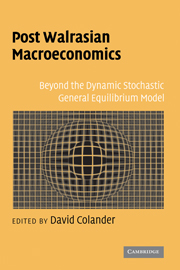Book contents
- Frontmatter
- Contents
- List of Contributors
- Foreword by Alan Kirman
- Introduction
- PART I WHERE WE ARE IN MACRO AND HOW WE GOT THERE
- PART II EDGING AWAY FROM THE DSGE MODEL
- PART III LEAPING AWAY FROM THE DSGE MODEL
- PART IV LETTING THE DATA GUIDE THEORY
- 12 The Past as the Future: The Marshallian Approach to Post Walrasian Econometrics
- 13 Old World Econometrics and New World Theory
- 14 Four Entrenched Notions Post Walrasians Should Avoid
- 15 Confronting the Economic Model with the Data
- 16 Extracting Information from the Data: A European View on Empirical Macro
- PART V POLICY IMPLICATIONS
- Bibliography
- Index
13 - Old World Econometrics and New World Theory
Published online by Cambridge University Press: 02 December 2009
- Frontmatter
- Contents
- List of Contributors
- Foreword by Alan Kirman
- Introduction
- PART I WHERE WE ARE IN MACRO AND HOW WE GOT THERE
- PART II EDGING AWAY FROM THE DSGE MODEL
- PART III LEAPING AWAY FROM THE DSGE MODEL
- PART IV LETTING THE DATA GUIDE THEORY
- 12 The Past as the Future: The Marshallian Approach to Post Walrasian Econometrics
- 13 Old World Econometrics and New World Theory
- 14 Four Entrenched Notions Post Walrasians Should Avoid
- 15 Confronting the Economic Model with the Data
- 16 Extracting Information from the Data: A European View on Empirical Macro
- PART V POLICY IMPLICATIONS
- Bibliography
- Index
Summary
Since this volume is about Post Walrasian economics I must confess at the outset to feeling somewhat of an interloper. I take the defining characteristic of Walrasian economics to be the assumption that data can be well described by competitive markets with continuous market clearing. Much of my work over the past decade has been on the implications of indeterminacy and sunspots in Walrasian economies and, although the economies that I study are often not competitive, I have never felt confined by the assumption of continuous market clearing – on the contrary, in my view, market clearing is an irrefutable proposition once markets are defined broadly enough. I am nevertheless grateful to the organizers of the conference for the opportunity to collect together some ideas that I have been working on over the past few years in joint research with Andreas Beyer of the European Central Bank.
My work with Beyer begins with the observation that North American macroeconomists and European time-series econometricians often have difficulty communicating with each other. The main points of disagreement concern the way that theory should be confronted with data and the way that economists should treat expectations. Roughly speaking, the dominant paradigm in North America favors calibration and data is passed through a two-sided filter. The dominant trend in European econometrics points out that theoretical models often have rich implications for both low and high frequency components of the data; filtering data removes the low frequency component and throws away information that can potentially discriminate between competing theories.
- Type
- Chapter
- Information
- Post Walrasian MacroeconomicsBeyond the Dynamic Stochastic General Equilibrium Model, pp. 258 - 276Publisher: Cambridge University PressPrint publication year: 2006



